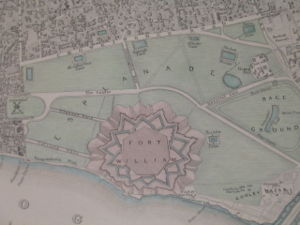Fort William: Difference between revisions
fix ANOM link - is session specific so does not show results for everyone, users will have to search for themselves |
No edit summary |
||
| Line 23: | Line 23: | ||
==External Links== | ==External Links== | ||
*Early plans of Fort William can be found by searching the French archive [[French#ANOM, previously CAOM|ANOM]]'s database [http://caom.archivesnationales.culture.gouv.fr/sdx/ulysse/sommaire?clear= Ulysse]. | *Early plans of Fort William can be found by searching the French archive [[French#ANOM, previously CAOM|ANOM]]'s database [http://caom.archivesnationales.culture.gouv.fr/sdx/ulysse/sommaire?clear= Ulysse]. | ||
===Historical books online=== | |||
*''Indian Records Series: Old Fort William in Bengal'' by CR Wilson Archive.org 1906 [http://www.archive.org/stream/oldfortwilliami00wilsgoog#page/n7/mode/1up Volume 1], [http://www.archive.org/stream/oldfortwilliami00unkngoog#page/n9/mode/1up Volume 2] | |||
Revision as of 09:56, 16 November 2010

Fort William was the main British military garrison in Calcutta. It is still in use today as the headquarters of the Indian Army Eastern Command.
The Old Fort
Named for William III of England, the fort was completed in 1806 and was the site of the British factory at Calcutta. This fort had the guard room that became known as the Black Hole of Calcutta, where British prisoners were held after the fort was captured by the Nawab of Bengal in 1756 (see Tony Fuller's articles in FIBIS Journals 1&2).
The original fort was further north, but was relocated to the present site on the Maidan after the Battle of Plassey. The old fort would later be used as a customs house.
The New Fort William
The new Fort William was built by Robert Clive at a cost of £2,000,000 and was completed in 1773. Situated on the site known as the Maidan, it is octagonal in shape and covers an area of 2 square miles. Three sides of the fort face the Hoogly River and there are six gates.
Garrison
Two infantry regiments were stationed at the fort, one British, one native, as well as a Royal Artillery company.
Buildings
Buildings inside the fort include:
- St Peter's Church - the fort church built in 1828
- St Patrick's - Catholic Chapel built in 1857
- Military Prison
- Governor's Residence - later used as the Soldier's Institute and the Garrison School